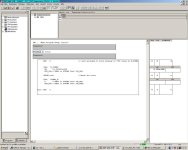I think that this whole thing boils down to, that S7 string handling including FC39 works as intended.
The problem started because the STRING[14] variable did not get an initial value AND because the manual assignment of the string length failed for some reason.
RMA,
you could post the entire code section, including the point where you assign "14" to the second header byte.
Then we could take it from there.
Maybe you have got it solved by doing the same thing in a different way. But it is still a good excercise to figure out why it went wrong the first time.
The problem started because the STRING[14] variable did not get an initial value AND because the manual assignment of the string length failed for some reason.
RMA,
you could post the entire code section, including the point where you assign "14" to the second header byte.
Then we could take it from there.
Maybe you have got it solved by doing the same thing in a different way. But it is still a good excercise to figure out why it went wrong the first time.







